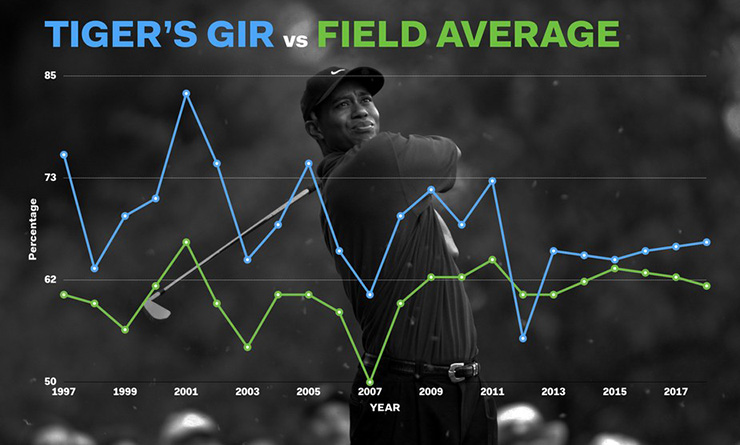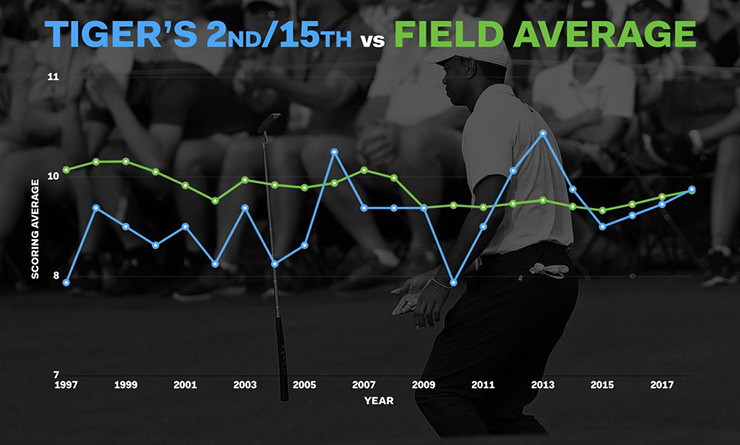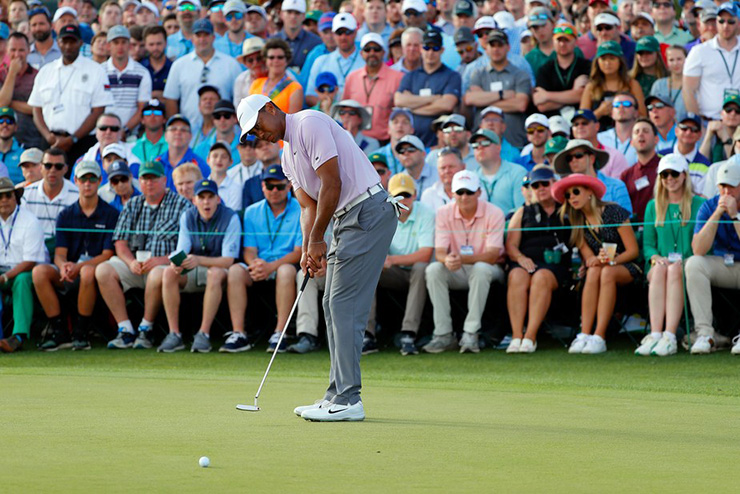(Photo by Mike Ehrmann/Getty Images)
By Joel Beall
It’s 18 holes away from an answer. There have been countless permutations and cadences to the discussion of Tiger Woods, but through the trials and triumphs, it’s always returned to one fundamental question: Can he win again at Augusta?
Yes, East Lake was magical, but the Masters is forever. So are legends, which Tiger Woods most decidedly is, and tomorrow the two could become one again.
Won’t be easy. Majors never are, but to win his first Masters in 14 years, Tiger will need to overcome Francesco Molinari (who’s somehow transformed from journeyman to assassin in the last 10 months) and history, as Woods has never won a major coming from behind on the final day. But he’s made it here, to this precipice, after all the surgeries, setbacks and second-guessing. What’s another 18 holes?
Here are the five things Woods needs to do to win on Sunday at Augusta National:
Figure out No. 5
Apparently, Woods missed the memo on the changes to No. 5, or perhaps he needs his eyes checked. For three consecutive rounds, Woods had placed his drive at the 495-yard behemoth into the fairway bunker, leading to a bogey on every occasion.
Perhaps “avoiding the trap” is too elementary a suggestion. That Molinari has played the fifth in even par, however, shows it’s paramount.
Keep up the iron work
Tiger’s approach game spurred his early Masters success, ranking no worse than T-8 in greens in regulation in eight of his first nine Masters starts. He led the field in greens hit during his first three wins, and came in second in the category during his 2005 victory. Over that span, Tiger averaged a 71.76 GIR mark versus the field’s 59.31 percentage.

TIMOTHY A. CLARY
Second-shot prowess is not just of importance to Woods. Adam Scott led the field in GIR during his 2013 victory, Sergio Garcia (’17) and Jordan Spieth (’15) ranked second in their wins, Bubba Watson T-4 (’12) and T-5 (’14), and Danny Willett (’16) coming in T-6.
After losing that advantage in the last decade at Augusta, that asset has returned for Woods this week. Only Thorbjorn Olesen has hit more greens through three days, with Woods boasting a 79.63 percentage. To make a Sunday run, his irons will have to continue lighting the way.
Where he needs to make a move
Sean Martin of PGATour.com calculated strokes gained per hole for the players who’ve won or been in a Masters playoff the last 10 years to discover where they separated themselves from the field. Martin found the breakaway happened on Nos. 3 and 14, the group picking up an average of 2.8 strokes per tournament.
Woods has made the most on the latter; should he win on Sunday, there may be a monument erected to his miraculous shot-n-slide in Round 2. Alas, he’s made three pars on the short-yet-stout No. 3, in each instance a so-so approach leaving tough birdie conversions.
Down two to Molinari and surrounded by a host of contenders, Woods will need more than red figures on par 5s, meaning he’ll need to play the third and “14th in one under tomorrow.
Speaking of par 5s…
Start taking advantage of the par 5s, especially No. 2
They read 5 on the card, but anything higher than 4 at the second, eighth, 13th and 15th feel like a loss. While it’s not fair to say Woods is fumbling the tournament on these holes, he hasn’t been a model of prosperity either, playing the 12 holes in five under. For context, Molinari is seven under, Tony Finau one better at eight.
The second has been particularly vexing, Woods finding the right greenside bunker on Thursday and Friday, his tee shot finding the beach off the fairway Saturday. He is just one under in three chances.
This is not a new development:

TIMOTHY A. CLARY
In his last 10 appearances, Woods has played the 15th a stroke worse per event than his first previous nine starts. This drop-off is mirrored on No. 2, losing 1.2 strokes. That may not seem dramatic, yet it’s amplified that the field’s scoring has improved (by roughly 0.2 strokes) in that time frame. It’s subtle, yes, but subtle enough where Woods has gone from a par-5 savant to squarely in the middle of the pack.
Though driving has historically been the root of these issues (especially on No. 2), this tournament has simply been a case of not bestowing himself makable birdie putts. He’ll need to do so tomorrow; anything worse than three under might be the death blow.

Kevin C. Cox
The putter needs to wake up
Woods entered the Masters ranked 74th in strokes gained/putting, 190th in one-putt percentage and 208th in three-putt avoidance. That record hasn’t improved much through three days. Tiger currently ranks T-29 in putting. A figure that doesn’t properly illustrate his short-game frustrations.
“The hardest part is I just can’t practice like I used to,” Woods said earlier this week. “My back gets sore. I just can’t log in the time that I used to and that goes with every part of my game.”
It’s a hard swallow, but reality. It’s also one Woods believes he can overcome with his irons. “Just put the ball in the correct spots so I can have gettable looks and gettable putts,” he asserted Saturday night. Which is somewhat true; conversely, Adam Scott’s round is a testament that won’t solely do the trick.
Woods and his Cameron go back to 1999. It was his Excalibur, winning 13 majors with the putter. It’s been more relic than weapon these last two years, dangerous in name only. But for Woods to make history, he’ll need to do it with his putter serving as sword.









